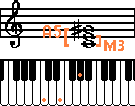 Em
Em  Bm
Bm 
A series of theory tutorials for the theory challenged or theory curious.
Last time:Naturally Minor
This time:
The key signatures used for the Harmonic Minor scales are the same as the Natural Minor scales.
Am  Em
Em  Bm
Bm 
 C#m
C#m  G#m
G#m  D#m
D#m 
Am  Dm
Dm  Gm
Gm 
Cm  Fm
Fm  Bbm
Bbm 
Ebm  Abm
Abm 
Remember that a key signature lets us know at a glance all of the notes which are altered during a piece or section. We name each key signature according to its corresponding minor scale because different collections of sharps/flats represent different minor scales.
Unlike the natural minor scale, the harmonic minor scale contains an altered note. It is still built on the relative minor of any Major scale.

The pattern here is
T~S~T~T~S~T½~S
One thing that jumps out is that the interval (distance) between the sixth and the seventh note of the scale is much larger than we have seen before: a tone and a half.
People generally think of this interval as being Arabic in nature, but it is common in many different musical cultures. It is called an augmented 2nd but it is the same as a minor 3rd if we were to hear it in isolation.
The raised seventh in this scale allows us to create a dominant chord that is major, making chord progressions sound more final.
The harmonic minor scale is not usually used as a melodic scale, although there is a rich tradition of its use in Klezmer, a musical tradition of the Ashkenazic Jews of Eastern Europe.
We can apply similar rules as those we used for getting the major scales right to getting this scale right for any given starting note. Or we just drop the key signature required in front, sharpen the seventh note as we write the scale and it will work straight away.
A Minor

E Minor

B Minor

F# Minor

C# Minor

G# Minor

D# Minor

A Minor

D Minor

G Minor

C Minor

F Minor

Bb Minor

Eb Minor

We use the same process we used for building chords on the major scale.
When we build chords above the notes of this scale, we notice that the chord built on the fifth note of the scale is a major chord. We also notice that chord III has a raised fifth (#5); this is the augmented chord. Chord vii is a diminished chord.

As before, all the major chords have the same interval structure: Major third above the bottom note, known as the root note, and a perfect fifth above the root note.


All the minor chords also have the same interval structure: minor third above the root and a perfect fifth above the root also.


The diminished chords consist of a minor third above the root with a diminished fifth above the root.


The augmented chord consists of a major third above the root with an augmented fifth above the root.

Next time:
All materials are © 1998~2010 Shane Kershaw aka Bandcoach
Keys, Scales, Chords: Marmonically Minor
by
Shane Kershaw aka Bandcoach
is licensed under a
Creative Commons Attribution-Noncommercial-No Derivative Works 2.5 Australia License
Permissions beyond the scope of this license may be available by contacting the author via this site.